Training Scent Identification Work with Dogs in Holland
I went to Holland the first week in September 1996 to video the Royal Dutch Police Dog Championships (KNPV) and to visit The Rotterdam Police Dog School. On a previous trip to Holland (in 1988), I had met Jan de Bruin (the head of the Rotterdam Police Dog School) at a club KNPV trial. We had talked about his work with scent identification dogs and the article I wrote that was widely published on the subject. I was very interested to do a follow-up visit and see where his studies and work had taken him. This article details some of what I saw.
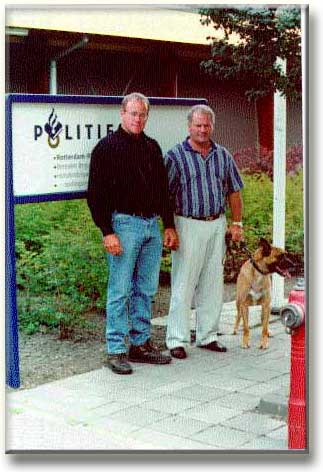
I will quickly review what de Bruin's program on scent identification did back in 1989. The Rotterdam police inspectors had been trained to collect human scent samples from a crime scene. These samples were collected on special sterilized gauze pads. These pads were then sealed in sterilized glass jars and stored in special evidence rooms at the police department. When a suspect for the crime was located, the Rotterdam Scent Identification dogs were allowed to smell the gauze pads that had been collected from the crime scene and then pick the suspect out of a lineup. Now this is the program in its simplest description. If you want to learn the entire 1989 program, you should refer to my earlier article Police Service Dog Work in Holland because there is a lot more to this early work than I explain here.
Over the past 6 or 7 years, Jan has refined his program tremendously. Where it used to take 18 months to train one of these dogs, he now feels that his instructors can train a dog in 2 to 3 months. He has also stopped using a human lineup. Instead, he now has the dog smell a series of gauze pads that contain human scent, collected from a lineup of outside people (one of which is the suspect). This eliminates any fear odor that a suspect would display toward a dog.
Here is how the program works now.
De Bruin has built a special room at the Rotterdam Police Dog School that is only used for scent identification training and lineups. One wall in this room has 8 stainless steel funnel type cylinders built into the wall. Each cylinder is large enough for a dog to put his head in. At the back of these cylinders is a special container designed to hold the scented gauze pads. The system is built so that it can be easily sterilized after each use.
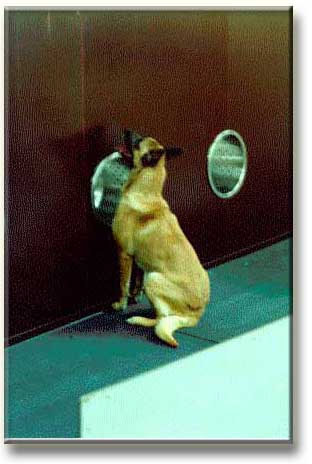
De Bruin designed a system that blows purified air through the gauze pads in the back of the cylinders. His research over the years has resulted in a cylinder and air flow design that only allows the dog to smell air that comes through the gauze pads at the back of the cylinder when the dog's head is inside these cylinders.
The air that passes through the scented gauze has been purified by big carbon scrubbers. Jan has done the equivalent of wind tunnel experiments using smoke to verify his design. He wanted a design that would produce one spot inside the cylinder where the only air that reached the dog's nose was the air that came through the gauze pads.
On the wall above each of the six cylinders is an opening where a tennis ball can be dropped through as a reward for a correct identification.
Here is how the system works.
When a suspect is located, he and his lawyer are brought to the dog school along with 11 volunteer citizens that live in the neighborhood where the suspect lives. De Bruin wants people that live in the same environment and eat the same food as the suspect.
All 12 people are asked to wash their hands with a special non-scented medical hand soap. They are then asked to sit at a table and hold a piece of sterilized gauze pad in their hands for 5 minutes. After that these pads are placed in sterilized containers.
The suspect's lawyer is allowed to pick 5 scent pads from the 11 volunteers. The lawyer is also allowed to pick which of the 6 stainless steel cylinders his clients scent pad will be placed in. The dog handler is not present during any of the scent collection or during the loading of the cylinders.
Once all six cylinders are loaded with the scent, the pad that contains the scent that was collected from the crime scene is loaded into a special cylinder by the door leading into the room.
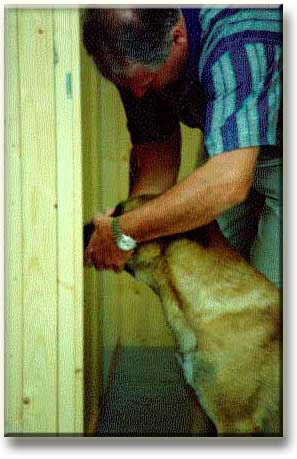
Once done, the dog and handler are brought to the room. The dog is allowed to smell the crime scene scent. The handler actually holds his dog's nose in the small opening containing the scent for about 30 seconds. When satisfied, the dog is released in the room and the handler leaves. The door to the room is closed and no one is in the room with the dog while he works. The dog is observed through a one-way mirror. He is also videotaped by a remote camera for later court use.
The dog is trained to go to each of the 8 cylinders. When he finds a cylinder with the same scent as that which has been collected at the crime scene, he sits in front of the cylinder. At that point, a ball is released through the opening above the cylinder and the dog gets his reward for a job well done.
After this, all of the scent samples are removed and the cylinders sterilized. Then the scent samples from the remaining people that volunteered for lineup duty are placed in the cylinders. The suspect's scent is no longer present. The process with the dog is repeated.
This time the dog smells all 8 cylinders. When he does not find the suspect's scent, he goes to a 9th spot in the room and sits down. This is his way of indicating that he does not smell the crime scene scent in any of the 6 cylinders. De Bruin calls it a "negative." At that point, a ball is released from above the 7th spot and the dog is rewarded for correct identification.
Each suspect is presented with 2 lineups. One contains his scent and the dog must match it to the crime scene. The second is a negative search and the dog indicates that the suspect's scent is not present by going to station 9. The research and work that de Bruin has done on this training is impeccable. The Dutch courts accept the training records of the dog and the methodology of the training. They put people in prison with this system.
De Bruin told me they checked the records on one dog. He was used in 167 criminal cases. He positively identified 78 suspects, he indicated 85 negatives, and made 4 errors. An error is when the dog identifies one of the 11 volunteer people as a match for the crime scene scent. This error rate is far less than our US Customs service accepts for narcotics dogs. The Customs Service will certify a dog with a 93.7% success rate. The Dutch will put a dog into service when his training records indicate a 95% success rate.
Once the dogs are put in service, their training never stops. The 4 scent I.D. dogs that are being used in Rotterdam are run through 3 to 4 training exercises, 5 days a week. De Bruin has proven that a dog's scenting ability improves with constant use. If training is reduced, the dog's scenting ability will decline. Over the next year, Jan will be conducting experiments in his new training room to try and answer definitive questions on a dog's ability to identify a scent.
Rotterdam's 4 scent identification dogs are busy all the time. This system allows other police departments in Holland to use these dogs by simply collecting scent at the crime scenes and mailing or bringing the gauze pads with the crime scene scent to the Rotterdam Police Dog School.v
It should be noted that the collection of scent at a crime scene is something that requires special training. There is enough information on this work to do a separate article on.
The beauty of the system is that when evidence is found (i.e., gun), they simply wrap a sterilized gauze pad around the handle of the gun for 20 minutes. This can be done in such a way that it does not damage fingerprints or DNA evidence. The gun is then sent off to the crime lab for normal processing.
I doubt this system will ever be used in this country. Simply because of the expense involved in building one of these rooms. I did not ask De Bruin what the cost was but it is not cheap. While there, he was scheduling a meeting with some government officials to explain why so much money was spent on this room (it had just been completed the month I was there). If I had to guess, it would be close to $100,000.00 or more to build the pressure system and special stainless steel cylinders.

In my opinion, the only law enforcement agency in America that could afford to do this would be the FBI. In fact, my personal feeling is that this is such a viable system that they should consider it. Field agents could be trained in scent collection and samples could be mailed to one centralized kennel for line-up purposes.
De Bruin has trained police departments from other countries. Germany, England, Sweden, Denmark, and Singapore just to mention a few that have come and studied the use of this system.
Just before I left, we talked about hard surface tracking. Rotterdam has 52 patrol dogs—all trained to track. But they have 4 dogs that receive special tracking training (like the 4 scent ID dogs). These dogs are called for special cases and are superior tracking dogs.
De Bruin starts his tracking training on a hard surface (concrete and asphalt). It is not unusual for his Rotterdam tracking dogs to be able to follow a nighttime track that is 2, 3, or 4 hours old on concrete and asphalt. I was told that if the dog can get to the scene within 2 hours of the suspect running in the city, the dogs can track them 95% of the time. Obviously, if the crime is during the day and it is hot out, the limit is 20 to 30 minutes.
De Bruin invited me back next year to watch how they train the hard surface tracking. I hope to get enough information to produce a training video on the subject.
If you would like to read more about the Rotterdam scent I.D. Program, read my article that was written back in 1989 titled Police Service Dog Work in Holland.
If you want to read articles on tracking, read Tracking Through Drive vs. Foot Step Tracking (LINK)
If you want to learn to do this training, view these videos:
- The Royal Dutch Police Dog Trails - KNPV
- Training Tracking Dogs for Police S&R
- Urban and Suburban Tracking
- Track Laying for Police Tracking Dogs





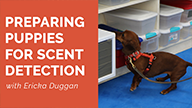
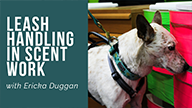
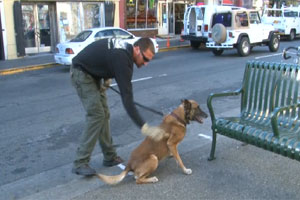
Ask Cindy.